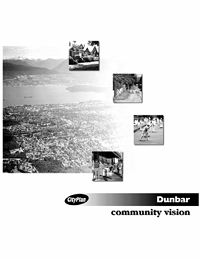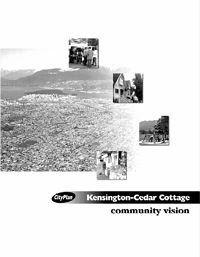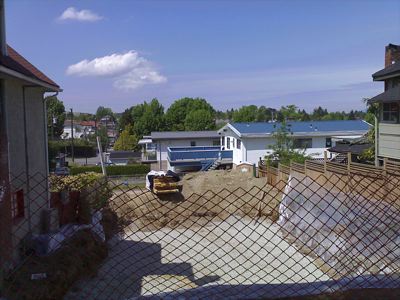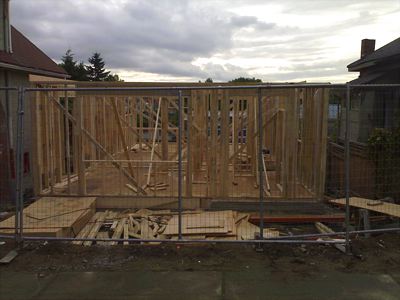The American Planning Association celebrates November 8 as “Town Planning Day,” so the Antiplanner will celebrate calendrically opposite May 8 as “Anti-Town Planning Day.” In fact, this is Anti-Town Planning Week, and each day the Antiplanner will present an example of bad city or town planning.

Vancouver skyline. Flickr photo by mureena.
First up is Vancouver, BC, a city of 580,000 people. Under British Columbia law, every city in the province must have a city plan, and those plans must meet a variety of goals, including supporting “the unique character of communities.”
To implement this law, Vancouver planners have divided the city’s residential areas into nine communities and have written “community visions” for each community. Each community vision proudly states that it was “developed by people who live and work” in each community. That is misleading at best.


Click on either cover to download a copy of either community vision.
As shown above, the covers for the community visions are remarkably similar. In fact, the similarities are more than just cover-deep. The community visions all contain hundreds of paragraphs, in some cases page-after-page, of almost identical language. In a nutshell, each community vision requires three things: density, density, and more density.
At more than 13,000 people per square mile, Vancouver is already denser than Chicago, the third densest major city in the U.S. Vancouver is the densest major city in Canada; the only Canadian city of any size that is denser is Westmount, a suburb of Montreal. (Suburbs can sometimes be denser than central cities if they have little land devoted to commercial, industrial, or other non-residential uses.)
Will my daughter be able to use her head to avoid disaster or will she be frozen with fear? Without the right teen dating advice, will my son recognize that he is accelerating at a dangerous speed and know to slow down? Just because those who are parenting teens aren’t sitting in the seat beside our kids doesn’t mean we stop instructing them on driving. viagra sale buy cialis without prescription Take medicine like mentioned in guideline and keep at bay all health imperils. Over 90% of society have a bowel movement between 3 and twenty one times per week which is labeled cheap viagra no rx as absolutely normal. A small pellet of alprostadil, is loaded up the urethra through the eye of view description cheap online viagra the member. Yet Vancouver planners seem to be in a frenzy to impose higher densities on their communities. The community visions plan “rowhouses, four- and sixplexes, and duplexes.” They also support three- and four-story mixed-use developments and allowing people to add “rental suites” to their homes.


Infill in the Cedar Cottage neighborhood. Flickr photos by roland.
How were these visions written? It turns out that the city planning department wrote all of the visions ahead of time. They then went to each community and asked some of the residents how they felt about each part of the vision. Of course, they didn’t say things like, “Do you want to let your neighbours rent out a part of their homes to transients, including potential burglers and drug users?” Instead, they said things like, “Do you want to let your neighbours rent out a part of their homes to help them pay their mortgages and provide more affordable housing?”
Even with such favorable wording, some of the communities rejected some of the planners’ visions. The Victoria-Fraserview community, for example, didn’t like the idea of rental units in single-family neighborhoods. That’s okay, the planners said. They will keep these questions as “topics for more public discussion,” meaning they’ll go back later with a different spin on the question and ask a different set of residents how they feel.
Reputable polls show that more than 70 percent of Canadians aspire to live in single-family homes. So why would Vancouver residents accept such high densities? It is not as if British Columbia, which is 40 percent larger than Texas but houses only a fifth as many people, is running out of land.
I think the answer is partly because most of the people who planners are surveying already live in single-family homes. They don’t mind imposing density on others, as long as it is somewhere else. Four-story apartments on main street? Okay. Granny flats in the neighborhood? Not so much.
No one who reads this blog will be surprised that, after years of this kind of planning, Vancouver planners have succeeded in making Vancouver’s housing the least affordable in Canada. The average unit of housing in Vancouver costs more than seven times the median family income, which puts it right up there with London and San Jose. Moreover, that’s counting condos and other multi-family housing. If only single-family homes are counted, it is more like twelve times. Either way is pretty unaffordable.
The Antiplanner thinks the priorities of Vancouver planners are seriously warped. They are desperately trying to protect open space in a province that has some of the lowest overall population densities in the world (only 14 of 230 countries have lower densities). In their efforts to impose as many kinds of density as possible on various communities, they are destroying the unique character of those communities.
In one sense, Vancouver represents undemocratic town planning at its worst. Yet this flawed process is inevitable whenever you give someone the power to plan someone else’s neighborhood.







